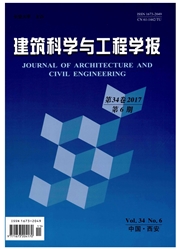

 中文摘要:
中文摘要:
基于混凝土冻融试验和混凝土细观力学对混凝土冻融后的力学性能变化进行了研究,建立了混凝土随冻融循环次数变化的强度折减模型和弹性模量折减模型。在混凝土冻融试验方面,采用快速冻融方法对混凝土试件和根据混凝土配合比制成的砂浆试件进行了100、200、300次的冻融循环,利用大型混凝土静、动三轴试验系统检测了冻融循环对海水中混凝土抗压强度、弹性模量及应力-应变关系的影响;在混凝土细观力学方面,对混凝土试件进行了数值模拟,为考虑各组成相的非均匀性,各组成相的材料性质按照Weibull分布来赋值,同时为反映冻融对混凝土的影响,砂浆的强度和弹性模量均以砂浆冻融试验所得结果为准。结果表明:该方法为进一步开展混凝土结构在冻融作用下的劣化机理与计算模型的研究提供了依据。
 英文摘要:
英文摘要:
Based on the freezing-thawing test and micro-mechanics of concrete, the mechanical properties of concrete after freezing thawing were studied, and the strength reduction model and elastic modulus reduction model were built with the changes of freezing-thawing cycles of concrete. In aspects of freezing-thawing test, the compressive tests of concrete specimens and mortar specimens which were made according to the ratio of concrete suffering 100, 200 and 300 cycles of freezing-thawing were completed. Using the large static-dynamic triaxial test system for concrete, the influences of cycles of freezing-thawing on the compressive strength of concrete, elastic moduli and stress strain relationships were tested. In aspects of micro-mechanics, examination of the concrete specimen was numerically simulated. To consider the non-uniformity of the various components, the nature of the material of the various components was assigned in accordance with the Weibull distribution. In order to reflect the impact of freezing-thawing to concrete, the strength and elastic modulus of mortar specimens were both assigned according to the results of mortar freezing thawing test. The results show that this method can offer references for further research on deterioration mechanism and calculation model of reinforced concrete structures in actions of freezing-thawing cycles.
 同期刊论文项目
同期刊论文项目
 同项目期刊论文
同项目期刊论文
 Elastic analysis of stress-displacement field for a lined circular tunnel at great depth due to grou
Elastic analysis of stress-displacement field for a lined circular tunnel at great depth due to grou 期刊信息
期刊信息
